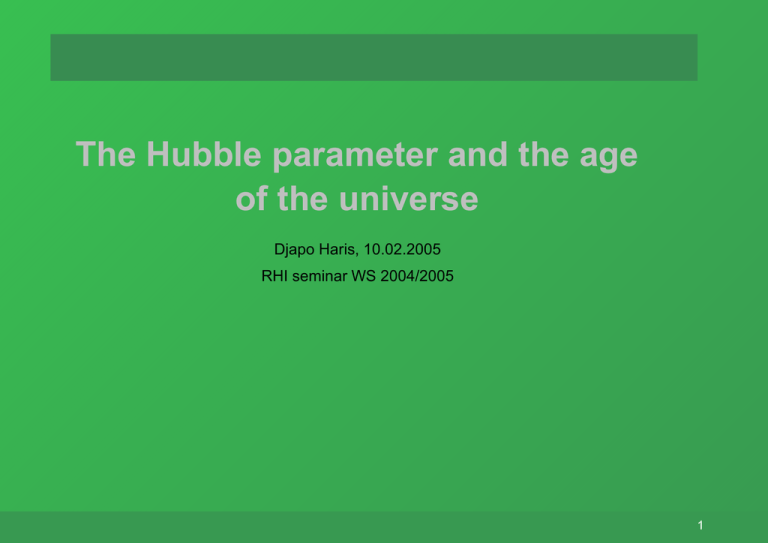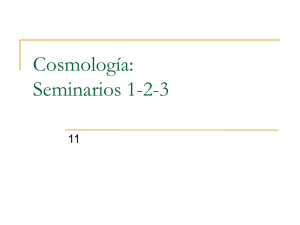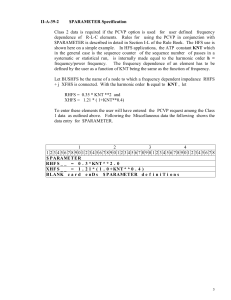The Hubble parameter and the age of the universe
Anuncio

The Hubble parameter and the age of the universe Djapo Haris, 10.02.2005 RHI seminar WS 2004/2005 1 Overview • Theoretical Model of Cosmology I Robertson-Walker metric I The Redshift I Friedmann-Lemaître equations I Standard model solutions I Cosmology parameters (definitions) I Flat adiabatic ΛCDM • Observations I Hubble’s law (observations) I CMB power spectrum I Matter content I Equation of state I Matter power spectrum I Cosmology parameters (observations) I Future projects • Summary 2 Robertson-Walker metric • Cosmological Principle • large scale homogeneity and isotropy • space-time metric ds2 = dt2 − a2 (t) dr2 1 − kr 2 + r 2 dθ 2 + sin2 θdφ 2 • k can only take discret values +1,-1 and 0 3 Expansion parameter • expansion parameter a(t) for low redshift can be approximated by a series a(t) = a0 1 1 2 2 1 − H0 (t0 − t) − q0 H0 (t0 − t) − j0 H03 (t0 − t)3 + · · · 2 3! • t0 − t lookback time • H(t) = 1 da(t) a(t) dt Hubble parameter h i−2 2 1 d a(t) 1 da(t) • q(t) = − a(t) deceleration parameter dt2 a(t) dt h i−3 3 1 d a(t) 1 da(t) • j(t) = a(t) jerk parameter dt3 a(t) dt 4 The Redshift • The redshifts connection to expansion parameter λ0 − λ e a(t0 ) z= = −1 λe a(te ) 5 The Redshift • The redshifts connection to expansion parameter λ0 − λ e a(t0 ) z= = −1 λe a(te ) • Hubble’s (luminosity distance) law z 1 dL (z) = 1 + [1 − q0 ] z H0 2 1 k 2 − 1 − q0 − 3q0 + j0 + 2 2 z 2 + O(z 3 ) 6 H 0 a0 5 The Redshift • The redshifts connection to expansion parameter λ0 − λ e a(t0 ) z= = −1 λe a(te ) • Hubble’s (luminosity distance) law z 1 dL (z) = 1 + [1 − q0 ] z H0 2 1 k 2 − 1 − q0 − 3q0 + j0 + 2 2 z 2 + O(z 3 ) 6 H 0 a0 • completely model independent, only Robertson-Walker metric assumed 5 Friedman-Lamaître equations • cosmological equations of motion are derived from Einstein’s equations Rµν 1 − gµν R = 8πGTµν + Λgµν 2 6 Friedman-Lamaître equations • cosmological equations of motion are derived from Einstein’s equations Rµν 1 − gµν R = 8πGTµν + Λgµν 2 • assuming that the matter content of the universe is a perfect fluid Tµν = −pgµν + (p + ρ)uµ uν 6 Friedman-Lamaître equations • Friedmann-Lemaître equations 2 ȧ(t) 8πGρ k Λ = − 2 + a(t) 3 a (t) 3 Λ 4πG ä(t) = − (ρ + 3p) a(t) 3 3 µν = 0 leads to • Energy conservation via T;µ ȧ(t) (ρ + p) ρ̇ = −3 a(t) 7 Standard model solutions • expansion history of universe • assume domination of one componet (radiation, matter, cosmological constant) • each componet distinguished by equation of state parameter w = p/ρ • integration of equation ρ̇ = −3(1 + w)ρȧ/a gives ρ ∝ a−3(1+w) 8 Standard model solutions • for w 6= −1, and neglecting the curvature and cosmological terms, we have a(t) ∝ t 2 3(1+w) 9 Standard model solutions • for w 6= −1, and neglecting the curvature and cosmological terms, we have a(t) ∝ t 2 3(1+w) • radiation dominated universe 1 1 −4 2 w = 3 , ρ ∝ a ; a ∝ t ; H = 12 t 9 Standard model solutions • for w 6= −1, and neglecting the curvature and cosmological terms, we have a(t) ∝ t 2 3(1+w) • radiation dominated universe 1 1 −4 2 w = 3 , ρ ∝ a ; a ∝ t ; H = 12 t • matter dominated universe 2 −3 w = 0, ρ ∝ a ; a ∝ t 3 ; H = 23 t 9 Standard model solutions • future universe expansion dominated by vacuum energy • equation of state w = −1 √Λ • simple solution a(t) ∝ e 3 t • w can depend on time in this case 10 Standard model solutions • future universe expansion dominated by vacuum energy • equation of state w = −1 √Λ • simple solution a(t) ∝ e 3 t • w can depend on time in this case 10 Cosmology parameters (definitions) • scaled Hubble parameter h, is defined via H = 100 h−1 km s−1 M pc−1 11 Cosmology parameters (definitions) • scaled Hubble parameter h, is defined via H = 100 h−1 km s−1 M pc−1 • critical density, such that k = 0 when Λ = 0 ρc = 3H 2 (t) 8πG = 1.88 × 10−26 h2 kg m−3 11 Cosmology parameters (definitions) • scaled Hubble parameter h, is defined via H = 100 h−1 km s−1 M pc−1 • critical density, such that k = 0 when Λ = 0 ρc = 3H 2 (t) 8πG = 1.88 × 10−26 h2 kg m−3 • density parameter for pressureless matter Ωm = ρ ρc 11 Cosmology parameters (definitions) • scaled Hubble parameter h, is defined via H = 100 h−1 km s−1 M pc−1 • critical density, such that k = 0 when Λ = 0 ρc = 3H 2 (t) 8πG = 1.88 × 10−26 h2 kg m−3 • density parameter for pressureless matter Ωm = • density parametter of the vacuum Ωλ = ρ ρc Λ 3H 2 (t) 11 Cosmology parameters (definitions) • scaled Hubble parameter h, is defined via H = 100 h−1 km s−1 M pc−1 • critical density, such that k = 0 when Λ = 0 ρc = 3H 2 (t) 8πG = 1.88 × 10−26 h2 kg m−3 • density parameter for pressureless matter Ωm = • density parametter of the vacuum Ωλ = ρ ρc Λ 3H 2 (t) • cosmological density parameter Ωtot = Ωm + Ωλ 11 Cosmology parameters (definitions) • scaled Hubble parameter h, is defined via H = 100 h−1 km s−1 M pc−1 • critical density, such that k = 0 when Λ = 0 ρc = 3H 2 (t) 8πG = 1.88 × 10−26 h2 kg m−3 • density parameter for pressureless matter Ωm = • density parametter of the vacuum Ωλ = ρ ρc Λ 3H 2 (t) • cosmological density parameter Ωtot = Ωm + Ωλ • present day parameters Λ ΩM = 8πG Ω = , 2 ρ0 , Λ 3H 3H 2 0 0 ΩK = − a2kH 2 0 0 11 Age of the universe • three competing terms drive the expansion: a matter term, cosmological term, and a curvature term • Friedman-Lemaître equations implies 1 = Ω M + ΩΛ + ΩK • ΩK measures how much the geometry differs from that of flat spacetime • deceleration paremeter is q0 = 12 ΩM − ΩΛ • if matter density is too large, the universe will recollaps before Λ-driven term becomes significant 0 0 ≤ ΩM ≤ 1 n h io3 ΩΛ ≥ 4ΩM cos 1 cos−1 ( 1−ΩM + 4π ΩM > 1 3 ΩM 3 12 Age of the universe 3 N o Bi g Ba ng • if ΩΛ is negative, recollapse is inevitable • Ωtot determines only the geometry of the universe • for Ωtot = 1 q0 = 0 implies ΩM = 13 .5 -0 q 0= 0 q 0= ting lera e c Ac ng rati e l e Dec 5 0. q 0= .7 % 95. 4% 68 .3% 1 99 ΩΛ • Ωtot value has a meaning for the expansion only if ΩΛ = 0 2 Expands to Infinity 0 Cl Recollapses os Op ed en Ω to t -1 0.0 0.5 1.0 ΩM ^ ΩΛ=0 1.5 =1 2.0 2.5 13 Age of the Universe • lookback time from redshift t0 − t 1 = = H0−1 Z H0−1 Z z1 0 dz (1 + z)H(z) z1 0 dz (1 + z) [(1 + z)2 (1 + ΩM z) − z(2 + z)ΩΛ ] 1/2 • the age of the universe is then t0 = H0−1 Z ∞ 0 dz (1 + z) [(1 + z)2 (1 + ΩM z) − z(2 + z)ΩΛ ] 1/2 14 Flat adiabatic ΛCDM • inflation results in Gaussian, adiabatic, nearly scale invariant primordial fluctuations 15 Flat adiabatic ΛCDM • inflation results in Gaussian, adiabatic, nearly scale invariant primordial fluctuations • growth of fluctuations depends on properties of matter and dark matter 15 Flat adiabatic ΛCDM • inflation results in Gaussian, adiabatic, nearly scale invariant primordial fluctuations • growth of fluctuations depends on properties of matter and dark matter • for CDM structure form bottom up, from small to progressively larger 15 Flat adiabatic ΛCDM • inflation results in Gaussian, adiabatic, nearly scale invariant primordial fluctuations • growth of fluctuations depends on properties of matter and dark matter • for CDM structure form bottom up, from small to progressively larger • for HDM structure form top down, from larger to progressively smaller 15 Flat adiabatic ΛCDM • inflation results in Gaussian, adiabatic, nearly scale invariant primordial fluctuations • growth of fluctuations depends on properties of matter and dark matter • for CDM structure form bottom up, from small to progressively larger • for HDM structure form top down, from larger to progressively smaller 15 Hubble’s law (observations) • Hubble’s law with distances, goes only up to z < 0.1 • mB apparent magnitude in the blue filter • average Hubble diagram, ∆z < 0.01 16 Hubble’s law (observations) • HSTkey project • ∆(m − M ) magnitude residual from empty cosmology • SN1999ff, lucky observation of a supernova at z = 1.7 1.0 1.0 0.5 0.5 ∆(m-M) (mag) ∆(m-M) (mag) • various models shown 0.0 -0.5 0.0 -0.5 Ground Discovered HST Discovered -1.0 ) dq/dz=0 (j0=0 eration, q0=-, el Constant Acc 0.5 Constant Deceleration -1.0 0.0 Coasting, q(z)=0 Acceleration+Deceleration, q0=-, dq/dz=++ Acceleration+Jerk, q0=-, j0=++ 0.5 1.0 z , q0=+, dq/dz=0 (j =0) 0 1.5 2.0 1.0 , (+Ω M= 1.0) +Ω M= Evolution ~ z ( t s u ay d z gr high- 0.5 0.0 -0.5 Ground Discovered HST Discovered ) q(z)=q0+z(dq/dz) ∆(m-M) (mag) ∆(m-M) (mag) 1.0 -1.0 0.0 -0.5 0.0 Empty (Ω=0) ΩM=0.27, ΩΛ=0.73 "replenishing" gray Dust 0.5 ΩM =1.0 , ΩΛ =0 1.0 z .0 1.5 2.0 17 CMB power spectrum • the acoustic peaks arise from adiabatic compresion of the photon-baryon fluid as it falls into preexisting wells in gravitational potential 18 CMB power spectrum • the peak characteristics are interpretes in terms of flat adiabatic ΛCDM cosmological model 19 CMB power spectrum • the peak characteristics are interpretes in terms of flat adiabatic ΛCDM cosmological model • the wells are enhanced by dark matter which cluster 19 CMB power spectrum • the peak characteristics are interpretes in terms of flat adiabatic ΛCDM cosmological model • the wells are enhanced by dark matter which cluster • first peak corespond to the scale of the mode that has compressed once 19 CMB power spectrum • the peak characteristics are interpretes in terms of flat adiabatic ΛCDM cosmological model • the wells are enhanced by dark matter which cluster • first peak corespond to the scale of the mode that has compressed once • the second peak arises from a refraction phase of an acoustic wave 19 CMB power spectrum • the peak characteristics are interpretes in terms of flat adiabatic ΛCDM cosmological model • the wells are enhanced by dark matter which cluster • first peak corespond to the scale of the mode that has compressed once • the second peak arises from a refraction phase of an acoustic wave • amplitude of the second peak decreases as ωb increases 19 CMB power spectrum • the peak characteristics are interpretes in terms of flat adiabatic ΛCDM cosmological model • the wells are enhanced by dark matter which cluster • first peak corespond to the scale of the mode that has compressed once • the second peak arises from a refraction phase of an acoustic wave • amplitude of the second peak decreases as ωb increases • for l > 40 TT spectrum predicts the TE spectrum 19 CMB power spectrum • the peak characteristics are interpretes in terms of flat adiabatic ΛCDM cosmological model • the wells are enhanced by dark matter which cluster • first peak corespond to the scale of the mode that has compressed once • the second peak arises from a refraction phase of an acoustic wave • amplitude of the second peak decreases as ωb increases • for l > 40 TT spectrum predicts the TE spectrum • for l < 20 TE spectrum is produced by reionized electron scattering the CMB quadrupole 19 Matter content • matter content is determined in several projects • universe evolves along the line of Ωtot = 1, if it is flat 20 Equation of state • constraints on the equation of state for dark matter • implication for the nature of the dark energy 21 Matter power spectrum • survey of very large volumes required • peak arises as a result of the sound waves in matter • primarely sensitive to Ωm and h 22 Cosmology parameters (observations) • "state of the art" constants on cosmological parameters • combination with the result obtained from CMB observations Joint Constraints on Cosmological Parameters including CMB data Constant w flat WMAP+Main w ΩK +LRG −0.92 ± 0.30 −0.80 ± 0.18 ··· ··· Ωm h2 0.145 ± 0.014 0.135 ± 0.008 w = −1 curved w = −1 flat WMAP+Main +LRG WMAP+Main +LRG ··· ··· ··· ··· ··· ··· −0.045 ± 0.032 −0.010 ± 0.009 0.134 ± 0.012 0.136 ± 0.008 0.146 ± 0.009 0.142 ± 0.005 Ωm 0.329 ± 0.074 0.326 ± 0.037 0.431 ± 0.096 0.306 ± 0.027 0.305 ± 0.042 0.298 ± 0.025 h 0.679 ± 0.100 0.648 ± 0.045 0.569 ± 0.082 0.669 ± 0.028 0.696 ± 0.033 0.692 ± 0.021 n 0.984 ± 0.033 0.983 ± 0.035 0.964 ± 0.032 0.973 ± 0.030 0.980 ± 0.031 0.963 ± 0.022 23 Cosmology parameters (observations) • recent improvement in determination of cosmic parameters • several other projects measure the same parameters, such as Lyα, SDSS etc. Various cosmological parameters from different sources 2000 2dFGRS HST WMAP 65 ± 8 76.6 ± 3.2 71 ± 8 71 ± 4 t0 [Gyr] 9 − 17 ··· ··· 13.7 ± 0.02 Ωb 0.045 ± 0.0057 0.042 ± 0.002 ··· 0.044 ± 0.004 Ωm 0.4 ± 0.2 0.231 ± 0.021 0.29+0.05 −0.03 0.27 ± 0.04 ΩΛ 0.71 ± 0.14 ··· 0.71 0.73 ± 0.004 Ωtot 1.11 ± 0.07 ··· ··· 1.02 ± 0.02 w ··· < −0.52 −1.02+0.13 −0.19 < −0.78 H0 h km s M pc i 24 Future projects • WMAP has presented only first-year results, there should be four, and then there is PLANCK 25 Future projects • WMAP has presented only first-year results, there should be four, and then there is PLANCK • high redshift supernova surveys will continue 25 Future projects • WMAP has presented only first-year results, there should be four, and then there is PLANCK • high redshift supernova surveys will continue • SNAP (SuperNova Acceleration Probe) 25 Summary • universe is described by RW metric • universe is, most likely, geometrically flat, but this cannot be experimentally proven • universe expansion is not linear • universe is accelerating propelled by dark energy • acceleration commenced at 0.5 < z < 1 • current observations of the universe the ΛCDM model best • best estimate of the value for the Hubble’s constant is H0 = 71 ± 4 • the age of the universe is ' 13.7 Gyr 26 Appendix A • measure radial coordinate r1 • looking back to time t1 when expansion parameter was a(t1 ) • r1 ,t1 and a(t1 ) cannot be directly measured • directly measurable quantities are: I the angular diameter distance; dA = D/θ = a(t1 )r1 I the proper motion distance; dM = u/θ̇ = a0 r1 L 1/2 I the luminosity distance dL = 4πl = a20 r1 /a(t1 ) • connection dL = (1 + z)dM = (1 + z)2 dA 27





